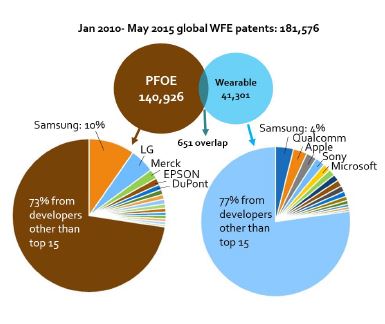Wearable electronics patents growing at 40% annually
There have been 41,301 patents published on wearable electronics from 2010 through May 2015 and filings are growing at a CAGR of 40%. However, there are gaps in the portfolio, particularly with respect to flexible electronics, say Lux Research.
Printed, Flexible and Organic Electronics (PFOE) has been a hot area of research as well, totaling 140,926 patents since 2010 – but the overlap between PFOE patents and wearables patents is tiny, just 651 publications. Samsung is the largest patent filer in both categories, accounting for 4% of all wearables patents and 10% of all PFOE patents.
“Flexible electronic components create the possibility of conformable, adaptable and immersive wearable devices that can seamlessly fit into everyday life,” said Tony Sun, Lux Research Analyst and lead author of the report: Are Wearables the Killer Application for Flexible Electronics? Finding the Overlaps, Gaps and Leaders. “However, the lack of overlapping patents between PFOE and wearables indicates a need and opportunity to develop and apply these technologies specifically for wearable electronic devices."

Lux Research analysts assessed patent filings for a variety of wearable technologies and scored them on key performance metrics. They found that E-paper displays, conductive inks and thin-film batteries fall into the 'overlooked' category as technologies that have a strong fit to wearables but haven't seen much innovation focus on wearable electronics applications.
By end application, 11% of global wearable patents are for consumer communications applications such as entertainment, device control and smartphone replacements. Analysts also found that health monitoring/athletics are close behind at 10%, but account for a full 25% of Samsung's filings. Compared with global data, Samsung also has a greater focus on arm/hand (35%) and head/neck (28%) form factors, reflecting its smartwatch and virtual reality headgear products. Also, 53% of its wearable patents are relevant to user output components, such as displays and speakers.





